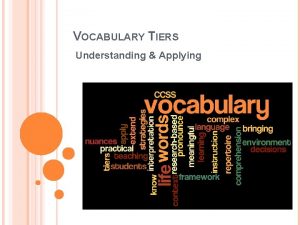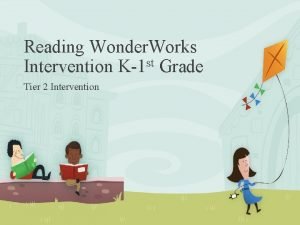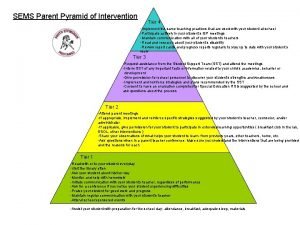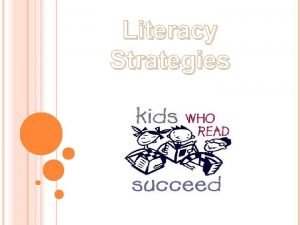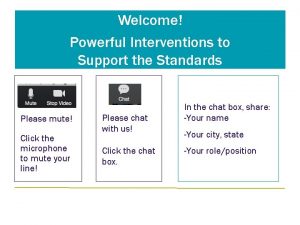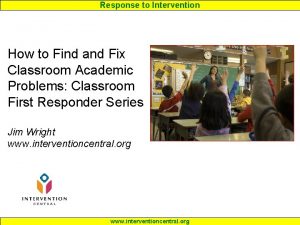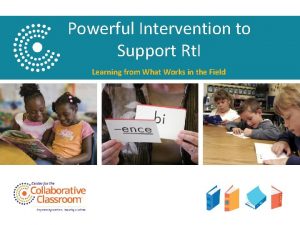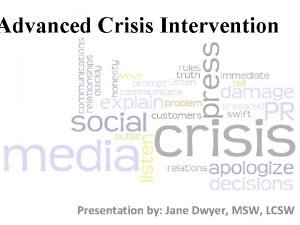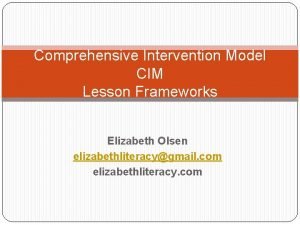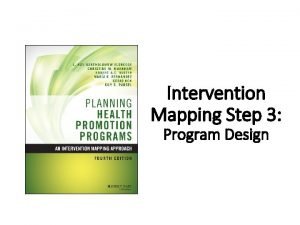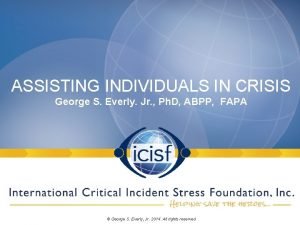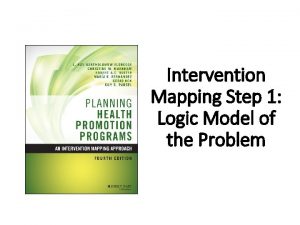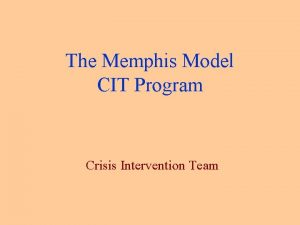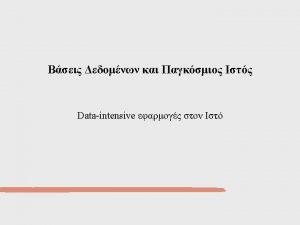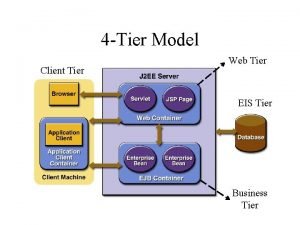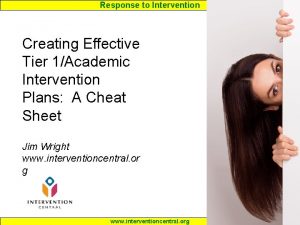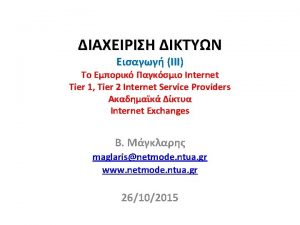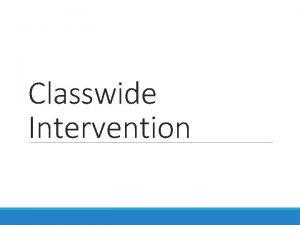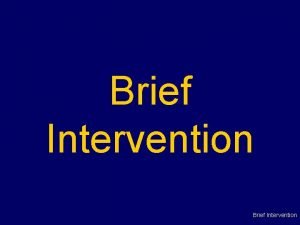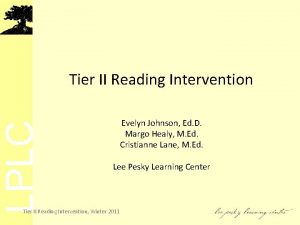The ThreeTier Model for Reading Intervention Tier III






























- Slides: 30

The Three-Tier Model for Reading Intervention Tier III Tier I

Three-Tier Reading Models • Use scientific research-based core, supplemental and intervention reading programs. • Use assessment data to drive differentiated instruction for all students. • Identify struggling students and provide the additional instruction/intervention support they need.

The Three Tiers • Tier I – Core classroom reading instruction to all students. • High quality core classroom reading instruction • • • Teach the essentials Explicit instruction Systematic instruction Differentiated instruction Instructional adaptations

Tier I Reading Instruction • 1. 2. 3. 4. 5. Incorporates the 5 essential components of effective reading instruction Phonemic Awareness Phonics Fluency Vocabulary Comprehension

Explicit Instruction Overtly teaching each step through teacher modeling and many examples. . Most children do NOT learn to read or spell “naturally” but instead learn from instruction

Explicit Instruction • • • Purposeful planning Model/explain clearly Re-teach and clarify Guided and monitored independent practice Scaffolding, corrective feedback, praise High rate of successful and accurate responses

The Importance of Practice • Provide a lot of opportunities for practice • Students need extended practice over time • What is practiced becomes a habit • Feedback is essential! Don’t let students practice their mistakes.

Systematic Instruction Dividing lessons and activities into sequential, manageable steps that progress from simple to more complex concepts and skills

Differentiated Instruction Differentiated instruction IS NOT: Using only whole class instruction Using small groups that never change Using the same reading text with all students Using the same independent seatwork assignments for the entire class

3 -Tier Instruction = Differentiated Instruction Differentiated instruction IS: • • • Using assessment data to plan instruction and group students Teaching targeted small groups Using flexible grouping (changing group membership based on student needs) Matching instructional materials to student ability Tailoring instruction to address student needs

Tier I Core Classroom Reading Instruction • Classroom teacher delivers to all students at least 90120 uninterrupted minutes of grade-appropriate core instruction. • Teachers conduct benchmark testing to monitor student progress and then, in response to testing results, adjust and differentiate instruction for students not meeting grade-level expectations. • Teachers use flexible grouping arrangements in small groups for students to receive targeted skill instruction

Tier I Core Classroom Reading Instruction • Grouping practices are a critical component of meeting the reading needs of all students. • Using a variety of grouping patterns helps teachers to differentiate instruction and respond to the needs of individual students.

Tier I Core Classroom Reading Instruction • Examples of Groups are: – Alternative groups – (one-on-one, pairs, small group, whole group) for different instructional purposes and to meet student needs. – Flexible grouping that provides opportunities for students to be members of more than one group and does not label the student as being in the “low group. ” – Small group rather than whole group instruction. Remember that as students master certain skills, new groups are formed. – Groups are continually created and recreated in response to student needs.

Assessment in Tier I • Involves the assessment of ALL students to: – Guide instructional decision-making – Monitor student progress – Identify struggling students who need intervention

Targeted Instruction • Meet students where they are • Go from the known to the unknown • Assessments guide instructional decisions • Teach them what they need to learn

You’re Teaching, but …. Are They Learning? • Don’t just “cover” critical content, teach it to mastery • When confusion is built on confusion, the result is a MESS • Reteach as needed • Practice, practice! • Monitor progress • Some students need more time to master critical content

Instructional Adaptations • Monitor students’ understanding and mastery of targeted objectives • Scaffold instruction to provide the support students need – DON’T WAIT!!! • Make adaptations to Tier I lessons

Even with high-quality, differentiated, core classroom reading instruction, there will be some students who require supplemental instruction of greater intensity.

High-Quality Tier II Intervention • • Targets struggling learners Includes additional, targeted instruction Involves frequent progress monitoring Uses assessment data to guide instruction

Features of Effective Tier II Lessons • Provide explicit and systematic instruction – Model with many examples – Break activities/tasks into small, manageable steps – Pace instruction to match students’ learning needs – Scaffold instruction

Features of Effective Tier II Lessons • Include many practice opportunities – Provide guided and independent practice opportunities – Maximize opportunities for students to participate and respond

Features of Effective Tier II Lessons • Provide corrective and appropriate positive feedback – Check for understanding

Tier II Intervention • Tier II focuses on students who do not achieve the minimum levels of satisfactory reading performance on essential grade-level skills. • Students receive 30 - 60 minutes of instruction in small groups (3 -5 students) each day, in addition to the uninterrupted 90 -120 minutes during the core block. • Typically implemented for a period of 8 – 12 weeks, but could be longer depending on student progress toward benchmarks.

Tier II Interventions • Progress of each student is monitored at least twice a month on the target skills (skills they have not mastered) to adjust instruction and ensure learning. • The professional providing the intervention may be the general classroom teacher, a specialized reading teacher, a reading coach, a special education teacher, or other personnel designated by the school and/or district.

Tier II Intervention • Student’s time in Tier II is flexible. After a round of Tier II instruction (8 -12 weeks), a decision is made about each student’s instructional needs. • Options for a student who has finished a round of Tier II instruction include discontinuing Tier II because benchmarks have been achieved, continuing with another round of Tier II intervention, beginning Tier III, and/or being referred for special education services.

How does Tier II reading instruction differ from Tier I reading instruction? • Tier II instruction is MORE explicit, systematic, intensive, and supportive, with struggling learners receiving MORE instructional time than just regular Tier I classroom reading instruction • Tier II instruction often focuses on phonological awareness, phonics and fluency in early grades • Tier II is conducted with small same-ability groups of 3 to 5 students within or outside the classroom • Tier II instruction involves frequent progress monitoring (every 2 weeks) to track student progress and inform instruction

Tier III Interventions • Tier 3 consists of general education instruction plus an individualized intervention (special education instruction) – Individualized instruction (1 – 3 students) – Two 30 minute sessions each day in addition to 90 minute block – Progress monitored at least every two weeks – Most qualified personnel needed to provide intensive instruction – Conducted in and out of the general education classroom. - Includes a strong supplemental curriculum - Referral for Special Education may or may not be warranted

Role of the Interventionist • 1) Possess the same knowledge about scientifically based reading instruction as the general classroom teacher • 2) Thoroughly familiar with the materials, techniques and philosophy of the core reading program • 3) Both the interventionist and the classroom teacher providing core instruction have a consistent, effective system of communication • 4) Has ready access to a variety of materials and knows how to use these materials aw well as strategies and techniques to target specific reading difficulties. • 5) The classroom teacher and interventionist conduct progress monitoring for each student.

Working Together to Increase Student Achievement General Education Special Education Title I

Believe in the Student Not my kids or your kids, but OUR KIDS!
 Tier 1 2 3 vocabulary words
Tier 1 2 3 vocabulary words Teir 3 words
Teir 3 words Wonders tier 2 intervention
Wonders tier 2 intervention Tier 4 intervention
Tier 4 intervention While reading activities
While reading activities Hamlet act iii scene ii
Hamlet act iii scene ii Leveled literacy intervention training
Leveled literacy intervention training Sipps levels
Sipps levels Intervention central reading fluency
Intervention central reading fluency Ccclearninghub
Ccclearninghub Nova crisis intervention model
Nova crisis intervention model Purpose and philosophy of nonviolent crisis intervention
Purpose and philosophy of nonviolent crisis intervention Generalist social worker definition
Generalist social worker definition Hybrid model of crisis intervention
Hybrid model of crisis intervention Comprehensive intervention model
Comprehensive intervention model Caplan model of crisis intervention
Caplan model of crisis intervention Intervention mapping model
Intervention mapping model Safer-r model
Safer-r model Logic model of the problem intervention mapping
Logic model of the problem intervention mapping Cit memphis model
Cit memphis model Iso 22301 utbildning
Iso 22301 utbildning Typiska drag för en novell
Typiska drag för en novell Nationell inriktning för artificiell intelligens
Nationell inriktning för artificiell intelligens Returpilarna
Returpilarna Varför kallas perioden 1918-1939 för mellankrigstiden
Varför kallas perioden 1918-1939 för mellankrigstiden En lathund för arbete med kontinuitetshantering
En lathund för arbete med kontinuitetshantering Särskild löneskatt för pensionskostnader
Särskild löneskatt för pensionskostnader Personlig tidbok fylla i
Personlig tidbok fylla i Sura för anatom
Sura för anatom Vad är densitet
Vad är densitet Datorkunskap för nybörjare
Datorkunskap för nybörjare
